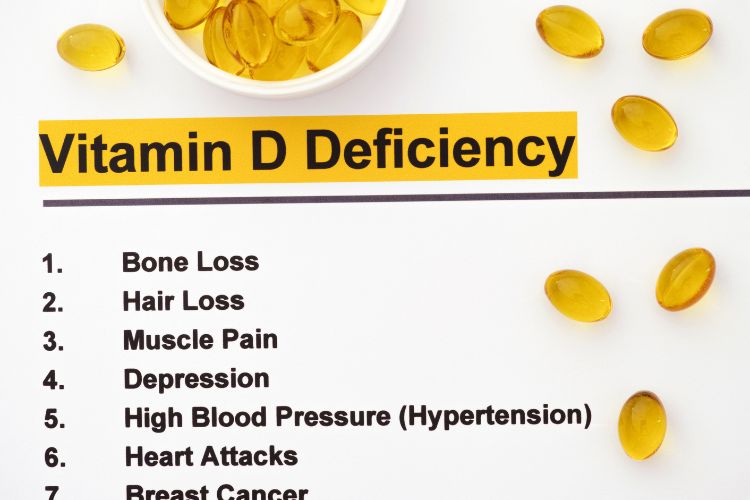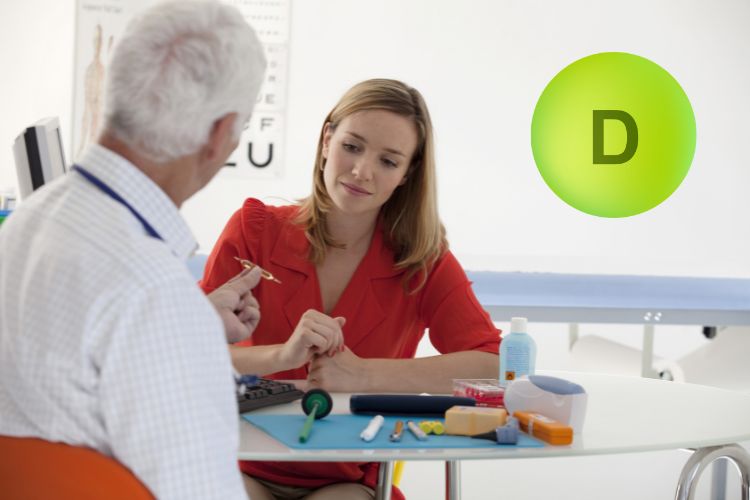Vitamin D is a vital nutrient that helps fight diseases, improve mood, reduce depression, support weight loss, and improve energy levels. However, more than one source has discovered that a vitamin D deficient state is common for most people. Many are calling it a silent epidemic that needs to be managed to avoid serious long-term problems.
In this article, we’ll answer questions like “What is the cause of low vitamin D?” and “What is vitamin D deficiency symptoms?” and “Vitamin D deficiency causes which disease?” and more. The goal is to help you understand why your vitamin D is low, what prevents good absorption of this vitamin, how you can quickly improve your levels, and ways to prevent serious nutrient loss.
Understanding Vitamin D Deficiency
Vitamin D deficiency is a problem caused by a lack of vitamin D and sun exposure in your life. In fact, vitamin D is typically most commonly produced by sun exposure to the skin, with fortified foods and supplements being the only other way to get this vitamin. As you might imagine, in a world that focuses mostly on staying indoors, vitamin D deficiency is a real problem for many people.
Just how serious is this problem around the world? Well, when medical sources say that there’s a silent epidemic, they might be underselling the problem: it’s more accurately called a pandemic. That’s because, according to statistics, 50% of the total global population is vitamin D deficient. These numbers get as high as 96% in Turkey and are particularly high in nursing home patients.
Risk Factors for Vitamin D Deficiency
So, what is the cause of low vitamin D? Typically, a lack of sunlight. People who spend most of their days indoors don’t get the UV rays they need to produce vitamin D. However, there are many other risk factors that can worsen your chance of this problem, including:
- Being a Person of Color: Darker skin has more melanin, which decreases its ability to create vitamin D. Only 5% of all African Americans have enough vitamin D in their blood.
- Diseases: Though lack of sunlight and poor dietary sources may cause vitamin D deficiency, kidney diseases, digestive disorders, and liver problems may also worsen your vitamin D absorbency.
- Obesity: Excessive body fat can trap vitamin D in your body in your fatty tissues and make it harder for your body to absorb this vital nutrient properly.
- Poor Dietary Sources: Excessively breast-fed babies, people with medically restricted diets, those with lactose intolerance, and anyone who doesn’t eat fortified foods may be vitamin D deficient.

Symptoms of Vitamin D Deficiency
If you think you’re vitamin D deficient, it’s important to not only know “What is the cause of low vitamin D?” but also “What is vitamin D deficiency symptoms?” While you should always confirm a diagnosis with your doctor before getting treatment, tracking your symptoms can help you figure out what might be affecting you and minimize long-term problems. A few signs of low vitamin D include:
- Frequent Illness: Are you someone who gets sick regularly or who struggles to overcome illness? Well, vitamin D boosts the immune system, and low levels might make you very sick.
- Fatigue: Low vitamin D levels will likely cause a high level of fatigue that may make your life very challenging. Large supplements can fight this problem effectively.
- Bone Pain: Do your bones seem to hurt frequently, or do you seem to suffer frequent fractures and breaks? Your vitamin D levels might be dangerously low, and you might need help.
- Depression: Depression, anxiety, and other mood problems seem to be heavily affected by vitamin D and typically require supplements to manage.
- Hair Loss: Vitamin D helps support hair health, and if you don’t have enough in your diet, you’re likely to experience hair loss issues.
- Weight Problems: Low vitamin D levels might contribute to weight gain, particularly if you’re not someone who likes to spend a lot of time outside.
A Look at Some Real-Life Examples
Here are a few scenarios of vitamin D deficiency to keep in mind:
Harry works 9-5 in an office environment, nowhere near a window. He parks in an underground garage at work and, when he gets home, spends most of his time indoors. Harry feels listless and depressed and gains weight regularly. His vitamin D deficiency is obvious.
Mary is a 76-year-old woman who doesn’t leave her nursing home much. When she first moved there, she was happy, and her bone health was strong. Due to limited sunlight and poor dietary choices, she’s bedridden and constantly in pain, with a high risk of bone damage.
Charlie works outdoors regularly and, when not working, likes to hike, swim, and simply relax in the sun. He rarely gets sick, always feels happy, and never runs low on energy. Furthermore, he drinks fortified milk every day. Charlie’s vitamin D levels are very high compared to Harry and Mary.

Consequences and Health Impacts
When you’re vitamin D deficient, you’re going to experience more problems than simple fatigue. Unfortunately, this condition is a widespread issue that might trigger a myriad of issues. That’s why it’s important to know the answer to the question “Vitamin D deficiency causes which disease?” as well as how you can avoid it.
In this section, we’ll highlight common issues that you might experience and provide more context into how severely they can impact your life if you don’t correct them. In later sections, we’ll help you learn how to increase your vitamin D intake quickly to minimize your health problems.
Bone Health
Vitamin D is vitally important to your bone health, and low levels can cause many serious problems. For example, low vitamin D levels might cause osteoporosis, which occurs when your bones are very weak. Furthermore, it might increase your risk of breaking your bones and reduce their healing speed.
It’s important to take these issues very seriously and to make sure you get help ASAP by getting a vitamin D supplement or figuring out what foods you can take to improve your vitamin D levels.
Immune System
Your immune system needs many nutrients to stay strong, chief among them vitamin D. A deficiency in this vitamin can increase your risk of various infectious conditions, inflammatory autoimmune diseases, lupus, and even multiple sclerosis.
Even if you don’t experience more serious health problems, low vitamin D reduces your ability to fight conditions and makes it harder for you to recover. As a result, you might seemingly bounce from one illness to the next with little to no respite.
Furthermore, low vitamin D could cause digestive problems that could also impact your immune system. For example, you might not properly absorb or digest calcium, which not only worsens your gut health but could potentially lead to broken bones and other issues.
Diagnosis and Treatment
As many factors can prevent vitamin D absorption (like age, medications, gastrointestinal diseases, obesity, and even skin color), it’s important to know how to manage this problem properly. Working with your doctor can improve your vitamin D levels and ensure you’re healthy.
Note that you should always work with your physician when your vitamin D levels are low to avoid toxicity risks. Taking too many supplements can actually adversely affect your health, so working with your primary caregiver can reduce this danger and keep you safe.
Diagnostic Methods
If you think you’re vitamin D deficient, your doctor will perform various tests that confirm your self-diagnosis. Typically, they perform a blood test by drawing a small sample and sending it to a lab. These professionals will check for your vitamin D serum levels to make sure they’re high enough.
It typically takes a few days or even a week to get these results back from the doctor. Once they’ve accurately assessed your vitamin D levels, they’ll come up with a treatment plan that works well for you. There are usually two facets of this approach: dietary changes and supplements.
Treatment Options
The most common way of managing a vitamin D deficient case is with supplements and lifestyle changes. Your doctor may suggest eating fatty fish like salmon, mackerel, tuna, beef liver, cheese, mushrooms, and egg yolks, as well as fortified meals like milk, orange juice, yogurt, soy drinks, and cereals.
Furthermore, you can take supplements that provide very high levels of this nutrient to keep you safe. In severe cases, you might need to get a shot to increase your vitamin D quickly. This option is only necessary if your levels are so low that you’re in danger of serious health risks.
Prevention Strategies
If you want to avoid becoming vitamin D deficient, there are several preventative strategies that you can take to improve your health. These include getting enough sunlight to produce healthy levels of vitamin D, as well as eating foods that are rich in vitamin D and very healthy.
However, it’s important to take both of these suggestions carefully to avoid overdoing anything and causing yourself serious harm. Thankfully, this process is easier than you might think and can minimize serious complications while improving your overall health and well-being.
Sun Exposure Guidelines
UV ray exposure is easily the best way to increase your vitamin D level, but can be problematic if you get too much exposure. Doctors suggest going outdoors during the mid-day, when the sun is at its peak, and letting rays hit your skin for at least 10-15 minutes without suntan lotion.
They suggest this level of exposure along your arms, abs, back, and legs for just 15 minutes before putting on a 30-SPF or higher sunblock. Keep the rest of your skin protected to avoid serious skin cancer risks. There’s a strong balance to take here that should keep you safe.
Dietary Recommendations
Beyond getting sun exposure, a diet filled with vitamin D-rich foods should help increase your levels and keep your health strong. There are many types of meals that can boost your vitamin D, increase your health, and minimize serious, long-term complications. By integrating these items into your regular diet, you ensure that your blood’s vitamin D stays high. Foods to eat include:
- Fatty Fish: Foods like herring, salmon, mackerel, tuna, sardines, and trout all have high vitamin D levels that can increase your content.
- Fungus: Though fruits and vegetables don’t have much vitamin D, reindeer lichen and mushrooms absorb vitamin D from the sun and can provide a great vitamin D source.
- Fortified Foods: Butter, milk, whole eggs, cheese, and yogurt often get fortified with vitamin D, which makes these foods a great source of this nutrient.
- Other Sources: Fish liver oils and dark chocolate all contain strong levels of vitamin D, which makes them useful for you if you’re looking to boost your levels quickly.
